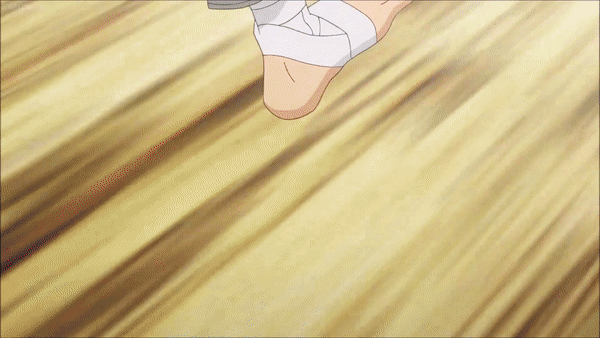Join the Discord →
Learn More →
See Project →
See About page
Multiple Jumps

Background
Multiple Jumps, also known as Double Jumping, Air Jumping, or Midair Leaping, is an ability that allows a user to leap additional times while already airborne. This power disregards standard physical laws—particularly Newtonian mechanics—which dictate that a jump must begin from a solid surface. Instead, users can generate new impulses midair to lift themselves higher, change direction, or maintain altitude.
This ability is commonly featured in video games, animation, fantasy settings, and superhero fiction. It is often interpreted in different ways depending on the universe’s logic: some characters seem to kick off invisible platforms, while others manipulate air pressure, release bursts of energy, or momentarily negate gravity. It may be physical, magical, or based on energy propulsion, and can range from a single extra jump to limitless aerial leaps.
In both gameplay mechanics and narrative combat, multiple jumps offer high mobility, access to elevated areas, and the ability to dodge or recover while airborne. In metaphysical or comedic contexts, the act may be symbolic of freedom, lightness, or even the breaking of conventional rules of reality.
Also Called
- Double Jump
- Midair Jump
- Aerial Step
- Air Hop
- Skybound Leap
- Consecutive Jump
- Repeat Jump
- Jump Boost
- Air Walk (in rare interpretations)
Possible Applications
- Law Manipulation/Physics Manipulation: By performing midair jumps, users may bypass or manipulate the physical laws that normally govern gravity and motion.
- Toon Force: Often depicted in a cartoonish context, midair jumping can function as a comedic or exaggerated gag.
- Flight: If a user can perform an unlimited number of jumps, they may effectively simulate or achieve flight.
- Enhanced Mobility: Traverse complex terrains with vertical hazards or structures that normal jumping cannot overcome.
- Combat Evasion: Dodge midair attacks, projectiles, or close-range assaults with repositioning leaps.
- Aerial Acrobatics: Perform chained movements, flips, and directional shifts for more versatile movement during battle or exploration.
- Platform Navigation: Access hard-to-reach locations, hidden platforms, or secret zones in platform-based environments.
- Recovery Technique: Regain aerial control or redirect trajectory after being launched or knocked into the air.
- Combo Extension: Maintain aerial combos in battle by staying airborne longer, connecting follow-up attacks or skills.
- Flight Simulation: When performed repeatedly or indefinitely, this ability may simulate hovering or flying.
- Momentum Management: Adjust forward, backward, or lateral motion while airborne to avoid overshooting or undershooting jumps.
- Stylization and Flair: Show off skill, creativity, or physical prowess with elaborate air movements.
Practical Uses
- Scaling tall buildings or mountainous terrain without external tools or flight.
- Performing wall-to-wall maneuvers in tight spaces for stealth or infiltration.
- Escaping traps or pits by chaining jumps back to safety.
- Retaining offensive pressure during aerial combat without needing to land.
- Dodging floor-based hazards or navigating spike traps and lava floors.
- Executing parkour-style traversal in urban or high-tech settings.
- Maintaining vertical dominance in a battle by staying above the opponent.
- Reaching airborne targets or intercepting flying enemies.
Variations
- Double Jump: Grants one additional leap after the initial jump. Common in platforming games.
- Triple Jump: Allows two successive jumps in the air before landing is required.
- Infinite Jump: No hard limit to midair jumps; user can leap as often as needed to remain airborne.
- Energy-Assisted Jump: Each jump generates thrust via jet propulsion, wind manipulation, or magical bursts.
- Wall-Based Jump: Requires a vertical surface to push off from (sometimes counted as a form of double jump).
- Contact-Based Jump: Allows the user to reset their jump count by making contact with enemies or objects.
- Charge-Based Jump: Each extra jump consumes stamina, energy, mana, or a similar resource.
- Skill-Gated Jump: User must time jumps precisely to chain them; mistiming results in falling.
- Gravity-Defying Jump: Jumps are achieved by selectively suspending or reversing gravity midair.
Possible Limitations
- Jump Limit: Most users have a hard cap—often one or two—on how many midair jumps they can perform.
- Resource Dependency: Requires energy, stamina, magic, or cooldowns, which may restrict frequency or reliability.
- Environment Sensitive: May be difficult or unusable in certain environments (e.g., water, space, low gravity).
- Diminishing Returns: Each additional jump might be weaker or cover less distance.
- Loss of Control: Excessive jumping may reduce directional control, making precise landings difficult.
- Counterable: Skilled opponents may time attacks or traps to intercept the user during predictable jump arcs.
- Not True Flight: Even if extended, the user is still vulnerable to gravity if they run out of jumps midair.
- Mental or Physical Demand: Multiple jumps might be physically taxing or require advanced coordination.
Users
- Hat Kid (A Hat in Time)
- Jak (Jak and Daxter)
- Characters from Super Smash Bros.